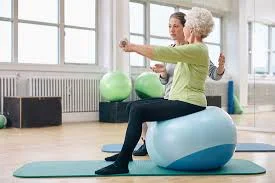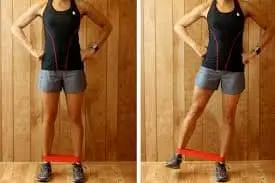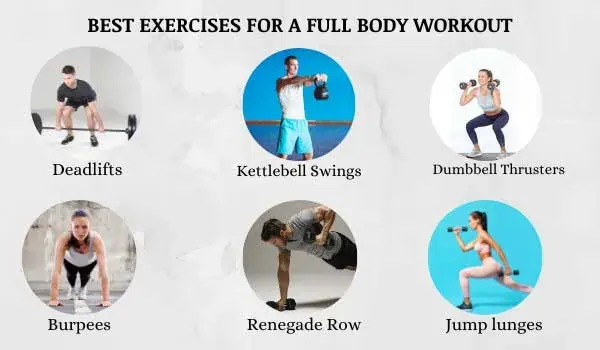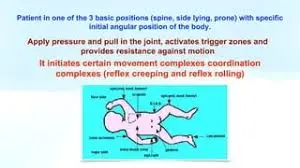20 Best Exercises For Triceps Tendonitis
Introduction:
Exercises for triceps tendonitis focus on reducing pain, improving flexibility, and restoring strength in the triceps and surrounding muscles. Gentle stretching, isometric holds, eccentric triceps extensions, and light resistance exercises help promote healing while preventing further strain.
Triceps tendonitis is an overuse injury causing pain and inflammation at the back of the elbow. Strengthening and stretching exercises can help relieve discomfort and promote healing.
Exercises for triceps tendonitis should be done with caution, particularly in the early phases of rehabilitation, as overstretching the tendon could worsen the problem.
It’s important to understand what triceps tendonitis is before beginning with the exercises. The triceps muscle, which is situated at the rear of the upper arm, is connected to the elbow joint by the triceps tendon. The elbow region experiences pain, swelling, and stiffness when this tendon gets irritated or inflamed as a result of overuse, repetitive motions, or sudden increases in intensity.
Activities involving lifting, pushing, or repetitive overhead motions are common causes of triceps tendonitis. For those with this condition, exercise, daily activities like lifting objects, and sometimes even relaxation can be difficult.
Causes:
This condition can result from several factors:
- Overuse or Repetitive Stress: The triceps tendon may get strained by repetitive activities, particularly those involving pushing or pulling. This is typical of athletes or others who engage in repetitive overhead motions (e.g., swimming or tennis), weightlifting, or throwing.
- Sudden Increase in Frequency or Intensity: Inflammation can result from suddenly raising the frequency or intensity of an activity or by beginning a new exercise regimen too soon.
- Incorrect Technique: Overloading the tendon and causing damage might result from performing activities with incorrect form or posture. For instance, using incorrect lifting techniques when lifting weights might put additional strain on the triceps tendon and elbow joint.
- Weak or Unbalanced Muscles: Overloading the tendon may result from weakness in the shoulder, forearm, or triceps. Muscle imbalances can also change how forces are transferred through the arm, which raises the possibility of injury.
- Prior Injuries: The development of triceps tendonitis may be more likely in individuals who have previously had an elbow or shoulder injury because of compensatory movement patterns or structural problems.
- Insufficient Warm-Up or Stretching: The risk of tendon strain can be increased by improperly warming up before exercise or by failing to stretch the triceps.
Signs and symptoms:
- The most noticeable sign is pain. Activities involving overhead lifting or pushing movements could worsen pain that is felt in the back of the upper arm, close to the elbow.
- Swelling: Especially after activity, there may be swelling or soreness around the elbow and triceps area.
- Stiffness: When trying to straighten the arm, the elbow may feel restricted in its range of motion or stiff.
- Pain with Particular Motions: Actions that require lifting, pushing, or overhead motions, including throwing a ball, lifting weights, or pushing things, may cause more pain.
- Tenderness to Touch: The affected area, such as the upper arm or elbow, may hurt when pressed.
- Weakness: Because the triceps are less able to work correctly, there could be a noticeable weakness when attempting to push things or extend the arm.
Benefits of exercises:
When performed properly, exercises for triceps tendonitis can be very helpful. By strengthening the muscles and tendons, improving flexibility, and preventing further injury, the proper workouts help in pain relief, function improvement, and recovery.
Exercises for triceps tendonitis provide the following main benefits:
- Encourages Recovery With Eccentric Strengthening
Tendonitis can be effectively treated using eccentric workouts, which cause the muscle to extend under tension. By strengthening collagen alignment and tendon strength, they help in encouraging the tendon to repair and rebuild.
- Strengthens Muscle and Tendon
By strengthening the surrounding muscles and triceps, you can prevent the tendon from getting stressed during everyday tasks. In addition to improving arm function, this can stop the injury from happening again.
- Reduces Inflammation and Pain
Stretching and strengthening activities might lessen tendonitis-related pain and inflammation when performed properly and regularly. By reducing corrective stress on the elbow, these exercises help in recovering normal movement patterns.
- Reduces Tension and Promotes Flexibility
Tendon tension may result from tight muscles, which can be lessened by stretching the triceps and other nearby muscles. Additionally, improved flexibility improves the general function and movement of the arms.
- Prevents Muscle Unbalances
Unbalances resulting from weakness in one muscle group can strain tendons. You may improve your muscle balance and lessen elbow strain by strengthening your triceps, biceps, and surrounding shoulder and forearm muscles.
- Restores Normal Range of Motion
The ability of certain workouts to help restore the elbow’s natural range of motion is one of its main advantages. By preventing stiffness and promoting more fluid arm movement, this helps with daily chores.
- Helps Prevent Long-Term Injuries
Performing strengthening and flexibility exercises after the tendon has recovered can help avoid further injuries. Moreover, it lowers the chance of chronic tendinitis and other arm ailments.
- Promotes Healthy Recovery Without Overuse
Exercises that are carefully selected help avoid stressing the tendon. Without reinjury or aggravating the condition, they help with healing and strength-building.
You can gain a lot of advantages by carefully and gradually performing these workouts. However, it’s important to pay attention to your body, refrain from ignoring pain, and allow the tendon enough time to recover.
When to Begin Triceps Tendonitis Exercises:
Exercises for triceps tendonitis should only be started after speaking with a physician or physical therapist. Recovery can be greatly affected by early intervention.
- Early Stage (Acute Inflammation): Rest, mild mobility exercises, and inflammation reduction should be the main priorities in the early stages of tendinitis. Strengthening activities could be too strenuous at this point, and it’s important to stay away from painful motions.
- Mid to Late Stage (Recovery and Strengthening): You can start doing strengthening activities gradually when the inflammation is gone. Exercises meant for regaining strength and flexibility become essential at this point as the tendon begins to heal and recover.
Consider the following safety measures before beginning an exercise program:
Before starting any kind of workout program, a few precautions should be taken to maximize the advantages. To figure out which exercises are most effective for your specific problem, speak with your physician or physical therapist.
It’s important to pay attention to your body and refrain from injuring yourself when you’re in pain. Even while soreness is a common side effect of exercise, prolonged or serious pain may be a sign of overworking.
Maintaining proper technique and posture can help prevent repetitive injuries. Consider speaking with a doctor if you’re unsure how to work out an exercise program. Warming up before you start will help your muscles and joints get ready for exercise.
Exercises For Triceps Tendonitis:
The following list of exercises is the best for treating triceps tendinitis:
French stretch
- Sit or stand up straight.
- Lift one arm above your head.
- Your hand should reach down toward the opposite shoulder blade as you bend your elbow.
- To increase the shoulder and triceps stretch, gently lift the bent elbow toward your head with your other hand.
- A deep stretch should be felt into your shoulder and along the back of your arm.
- Hold this position for a few seconds.
- Then take a neutral position.
- Then relax.
- Repeat this activity 5 to 10 times.
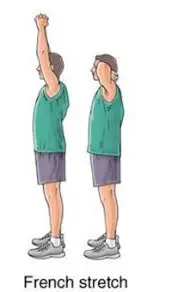
Eccentric Triceps Extensions
- Hold a light dumbbell in one hand while standing or sitting.
- Lift your arm above your head while maintaining a 90° elbow angle near your ear.
- Hold the dumbbell straight overhead and keep your hand facing forward.
- Bend your elbow and slowly lower the dumbbell behind your head while maintaining an unmoved upper arm.
- Here, it’s important to gradually reduce the weight over a count of three to four seconds.
- The eccentric portion of the exercise is the focus of this gradual lowering phase.
- To prevent using other muscles to compensate, keep your arm steady and your core active.
- Use your other arm or hand to help raise the dumbbell back up to the starting position after you have completely dropped the weight.
- By doing this, the eccentric movement is isolated without causing muscle exhaustion.
- Then take a neutral position.
- Then relax.
- Repeat this activity 5 to 10 times.
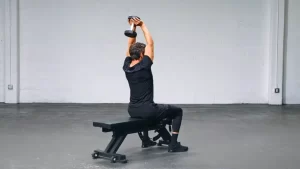
Bicep Curls (with Light Weights)
- The first step is to settle onto a chair or table.
- With your arms fully stretched toward the floor and your palms facing front, hold a light dumbbell in each hand.
- Maintain a relaxed shoulder position and keep your elbows near to your upper body.
- Using your biceps, bend your elbows and slowly curl the dumbbells upward.
- Make sure that only your forearms are moving and keep your upper arms still.
- Curl the weights until your biceps contract well or your forearms are almost parallel to the floor.
- To properly activate your biceps, squeeze them for one to two seconds at the top of the curl.
- While resisting gravity, slowly return the weights to their initial position.
- Lower the weights for 3–4 seconds to concentrate on the eccentric (lowering) phase.
- Then return to your neutral position.
- Then relax.
- Repeat this activity 5 to 10 times.
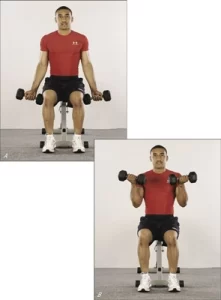
Triceps towel stretch
- Using both hands, grasp a towel or resistance band.
- Place your back in a neutral position and stand up straight.
- Raise one arm over your head and bend the elbow such that your hand extends toward the shoulder blade on the other side of your back.
- Grab the lower end of the towel behind your back with your other hand.
- The triceps of the overhead arm will extend more deeply if you use your bottom hand to gently tug on the towel.
- Both the back of your arm as well as your shoulder region should feel stretched.
- Breathe deeply and relax into the stretch as you hold it for a few seconds.
- Only pull lightly to prevent pain; try not to overstrain yourself or arch your back.
- Then return to your neutral position.
- Then relax.
- Repeat this activity 5 to 10 times.
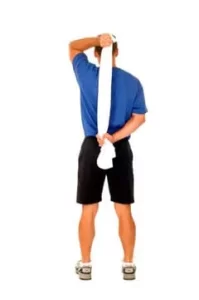
Tricep rope pushdown
- Fasten a rope to a cable machine’s high pulley.
- Focus on the machine while keeping your feet shoulder-width apart.
- Using a neutral grip, grasp the rope attachment with both hands and palms facing one another.
- With your elbows bent at a 90-degree angle, take a few steps back from the machine to generate tension in the cable.
- While keeping your back straight, your body should be slightly angled forward and your legs slightly bent.
- Keep your elbows close to your sides and stretch them to push the rope down toward your thighs.
- To truly work the triceps, spread your palms outward and split the rope apart at the bottom as you extend your arms.
- Don’t swing or use speed; instead, concentrate on moving the weight with your triceps.
- To get the most contraction, squeeze your triceps for a few seconds at the bottom of the exercise.
- Allow the rope to go higher, resisting the weight as you do so, and slowly return to the starting position.
- Keep your elbows close to your sides and don’t allow them to stretch out.
- Then return to your neutral position.
- Then relax.
- Repeat this activity 5 to 10 times.
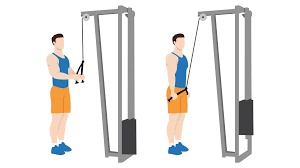
Triceps kickback
- In each hand, pick up a dumbbell (or utilize a cable machine that has a single handle attached).
- Maintain a 45-degree torso lean while standing with your knees slightly bent.
- Using a neutral grip, hold the dumbbells at your sides with your palms facing each other and begin with your elbows bent at a 90-degree angle.
- For the duration of the exercise, keep your elbows close to your body.
- Only your forearms should move; your upper arms should stay still.
- Straighten your arms and extend them at the elbow joint to push the dumbbells back.
- Control the action and concentrate on squeezing your triceps at the top of the exercise (when your arms are at their maximum length).
- To avoid straining your joints, keep your elbows slightly bent at the end range rather than locking them.
- Return the weights to the beginning position gradually while keeping control of the movement.
- Then relax.
- Repeat this activity 5 to 10 times.
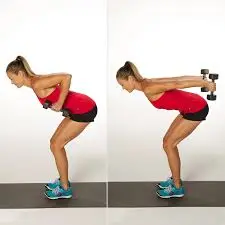
Overhead triceps stretch
- With your back neutral, stand upright.
- With one arm raised above your head, bend your elbow till your hand reaches the shoulder blade on the other side.
- To increase the stretch in your triceps and along your shoulder, gently pull your elbow toward your head with your other hand.
- The back of your arm, as well as possibly your shoulder and upper back, should feel stretched.
- Hold this position for a few seconds.
- Throughout the stretch, maintain stable and deep breathing to aid with muscular relaxation.
- Then return to your neutral position.
- Then relax.
- Repeat this activity 5 to 10 times.
- Repeat with the opposite arm switched.
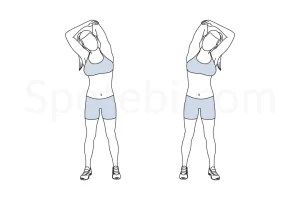
Supine Triceps Extension
- On a bench, lie flat on your back; if you don’t have a bench, lie on the floor.
- Take hold of a dumbbell with both feet.
- Hold the dumbbell with both hands around one end, palms up, if you’re using one.
- With the dumbbell slightly over your head, place the weights such that your elbows are bent at a 90-degree angle and your upper arms are parallel to your upper body.
- Your lower back should stay in contact with the floor and your feet should be flat on the ground.
- Reach up and press the barbell or dumbbell toward the ceiling with your elbows.
- Keep your elbows from locking at the top and concentrate on engaging your triceps to straighten your arms.
- Only your forearms should move during the workout; keep your upper arms as still as you can.
- You should experience a powerful contraction in your triceps at the highest point of the exercise.
- With your upper arms remaining inactive, bend your elbows and slowly lower the weight back down.
- Drop the weight back down until your elbows are at about a 90-degree angle, or a little bit deeper if you feel comfortable.
- Then return to your neutral position.
- Then relax.
- Repeat this activity 5 to 10 times.
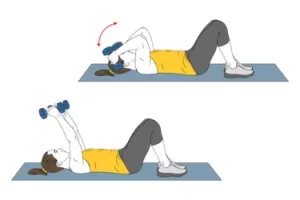
Elbow flexion
- Keep your arm by your side when you stand.
- After actively bending your elbow as far as it will go, take hold of your wrist or forearm with your other hand and apply a little pressure.
- You can relieve the strain by straightening your elbow after holding it bent for a few seconds.
- Then return to your neutral position.
- Then relax.
- Repeat this activity 5 to 10 times.
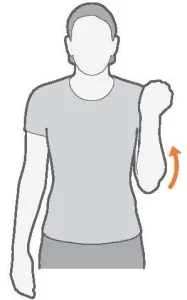
Bench Tricep Dips
- Place your hands close to your hips, fingers pointing forward, while seated on a bench.
- With your knees bent at an around 90-degree angle and your feet flat on the floor, you may extend the exercise by extending them straight.
- Using your hands to support your body, move your hips off the bench.
- Your elbows should not be locked, and your arms should be straight.
- Bring your body closer to the floor by bending your elbows to lower your body.
- Instead of letting your elbows spread out to the sides, keep them pointing straight back.
- Your triceps will be performing the majority of the effort thanks to this.
- When your upper arms are parallel to the floor, stop (or go a little deeper if you feel comfortable).
- To return to the beginning posture, push through your palms to extend your elbows.
- Then relax.
- Repeat this activity 5 to 10 times.
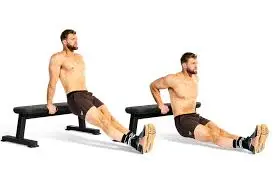
Cross-body stretch
- Maintain a straight back and relaxed shoulders while standing or sitting upright.
- One arm should be held shoulder-high in front of you.
- Maintaining the arm relaxed yet straight, bring the extended arm across your body to the opposing shoulder.
- Gently pull the extended arm closer to your chest with your opposing hand the one that isn’t spread across your torso.
- Pull your arm across your body while keeping your elbow slightly bent.
- Maintaining an upright position, raise your arm across your chest and rotate your shoulder inward.
- Hold this position for a few seconds.
- Throughout the stretch, take slow breaths and let yourself relax in the position without pushing yourself.
- Then return to your neutral position.
- Then relax.
- Repeat this activity 5 to 10 times.
- On the opposite side, repeat the stretch.
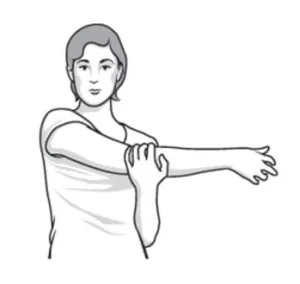
Dumbell-floor-press
- With your knees bent and your feet flat on the floor (hip-width apart), lie flat on your back.
- Place both dumbbells on your thighs and hold them in each hand.
- When you’re ready, raise each dumbbell one at a time until it reaches shoulder height with the palms facing forward (or slightly inward, if you like).
- Your elbows should bend as you lower the dumbbells.
- Don’t spread your elbows too far; instead, keep them at a 45-degree angle to your body.
- Allow your elbows to lightly tap the floor, and slowly and carefully lower the dumbbells.
- To avoid putting unnecessary stress on your shoulder, halt when your elbows just touch the floor.
- Controllably raise the dumbbells back up while fully extending your arms without locking your elbows at the top.
- At the height of the movement, concentrate on compressing your chest.
- For maximum muscular engagement and injury prevention, the motion should be slow and controlled, particularly during the lowering phase.
- Then take a neutral position.
- Then relax.
- Repeat this activity 5 to 10 times.
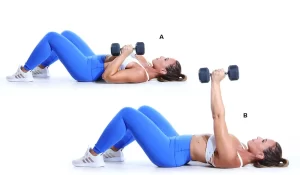
Sphinx-push-up
- Make sure your elbows are just beneath your shoulders when you place your forearms on the floor. Palms down, your hands should be flat on the floor; if you want more support, join them together.
- To make a straight line from your head to your heels, raise your hips.
- Your body should be in a straight line with your feet hip-width apart.
- Maintaining a straight body, go down your chest toward the floor while pressing against your forearms. The downward portion of a conventional push-up is comparable to this, except the majority of your body weight will be supported by your forearms.
- When you lower your chest, keep your elbows curled in (near your body) so that your shoulders and triceps can work.
- Your elbows shouldn’t slide too far away from your chest since your forearms should stay in contact with the ground.
- To raise your body again, extend your elbows.
- As you lift, make sure the movement is straight and controlled, using your shoulders, chest, and triceps.
- Keep your core strong and concentrate on pressing with your forearms.
- Avoid allowing your hips to rise or fall, and maintain a straight back.
- Then take a neutral position.
- Then relax.
- Repeat this activity 5 to 10 times.
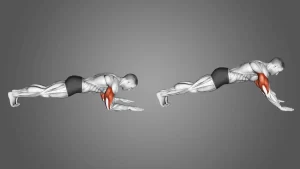
Diamond-push-up
- Place your hands directly beneath your shoulders and enter a conventional push-up position.
- Make a diamond formation on the floor by putting your hands close together so that your thumbs and index fingers contact.
- Your body should be in a straight line from your head to your heels, with your feet together. Keep your back from drooping by using your core and keeping your spine neutral.
- As you drop your body toward the floor, bend your elbows.
- Do not stretch out; instead, keep your elbows close to your sides and pointed back.
- Maintaining the diamond position with your hands, lower your chest until it is barely over the floor.
- Try to keep your body as straight as you can, using your legs and core to stay stable.
- Raise your arms straight and push your body back up.
- Throughout the exercise, concentrate on pushing through your palms and maintaining your elbows close to your sides.
- Maintain a controlled motion at the highest point by completely extending your arms without locking your elbows.
- Then return to your neutral position.
- Then relax.
- Repeat this activity 5 to 10 times.
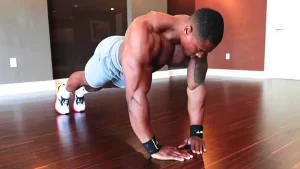
Wrist Extension Stretch
- Your arm should be straight out in front of you as you sit comfortably.
- Keep your palm down and your elbow straight.
- Pull your fingers gently back toward your body with your other hand.
- Your forearm, upper wrist, and maybe your elbow should all feel stretched.
- Hold this position for a few seconds.
- Don’t push yourself too hard; instead, keep the stretch light.
- Relax your wrist and gradually relieve the stretch.
- Then return to your neutral position.
- Then relax.
- Repeat this activity 5 to 10 times.
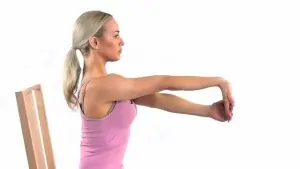
Single-Arm Dumbbell Floor Press
- Place your feet flat on the floor and bend your knees as you lie down.
- With one hand, hold a dumbbell while keeping your elbow on the floor and your upper arm at a 45-degree angle to your body.
- You can support yourself by placing your other arm on your hip or the floor.
- With your arm fully extended, press the dumbbell straight up toward the ceiling.
- Maintain a 45-degree angle between your upper arm and the ground by keeping your wrist straight and avoiding excessive elbow flex.
- Maintaining control of the movement, slowly lower the dumbbell back down to the floor until your upper arm lightly touches the floor.
- Be careful not to lower your elbow too much below the floor.
- Then return to your neutral position.
- Then relax.
- Repeat this activity 5 to 10 times.
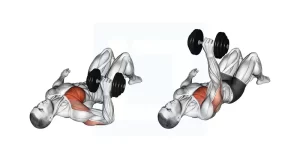
Plank Triceps Kickback
- Start in a high plank posture, which is comparable to the top of a push-up, with your core active, your body in a straight line from head to heels, and your hands directly beneath your shoulders.
- Pick up a dumbbell with one hand.
- If you’re more comfortable, you can put your feet closer together, or you can keep them wide for greater balance.
- Move the dumbbell closer to the center of your body while maintaining the plank position by bending your elbow.
- Maintain a 90-degree bend in your elbow and keep your upper arm close to your body.
- From here, straighten your elbow and stretch your arm backward until your hand is moving toward the wall behind you. The “kickback” part of the movement is this.
- Bend your elbow once more and slowly lower the dumbbell back to the beginning position while keeping control of the movement.
- Then relax.
- Repeat this activity 5 to 10 times.
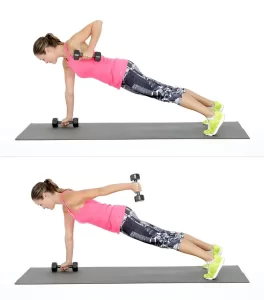
Alternating Triceps Kickback
- Hold a dumbbell in each hand, stand with your feet shoulder-width apart, and bend your knees slightly.
- Maintaining a straight back and a tight core, bend forward from the hips until your body is almost parallel to the floor.
- With your hands facing inward and your upper arms close to your body, you should have your arms bent at the elbows at a 90-degree angle.
- Squeeze your triceps at the highest point of the exercise, extend your right arm backward, and fully straighten your elbow.
- Only your forearm should move; keep your upper arm still and refrain from swinging.
- Once your right arm is fully extended, bend your elbow back to 90 degrees to bring it back to the beginning position.
- Then return to your neutral position.
- Then relax.
- Switch to your left arm right away and perform the same motion again: squeeze your triceps, straighten your elbow, and extend your arm backward.
- Repeat this activity 5 to 10 times.
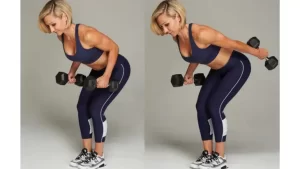
Overhead Triceps Extension (with Light Weight)
Targeting the triceps from a new angle, the overhead triceps extension helps in tendon repair and muscle strength development.
- Start with a standing position.
- Keep your core active and your knees slightly bent.
- Keep one dumbbell in each hand.
- To ensure a firm grip, push your hands together and wrap your thumbs around the handle.
- With your elbows pointed front, completely extend your arms overhead.
- Your elbows should be near your head, and your arms should be parallel to your upper body.
- With gentle elbow bending, slide the dumbbell behind your head.
- Keep your elbows as close to your ears as you can while keeping them pointed up.
- Depending on your comfort level and degree of flexibility, lower the dumbbell until your forearms are parallel to the floor or a little deeper.
- Keep your upper arms still and refrain from swinging as you slowly extend your elbows to get the dumbbell back to the beginning position overhead.
- To lessen the chance of strain, do not lock your elbows when you are fully extending your arms.
- Then relax.
- Repeat this activity 5 to 10 times.
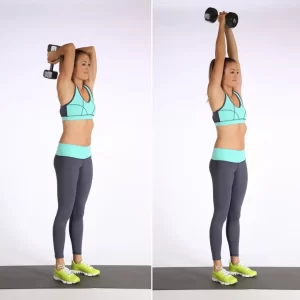
Isometric Triceps Contractions
- Take a stand upright.
- Press one hand’s palm flat against the surface.
- Make sure your elbow is comfortably bent, which is often about 90 degrees.
- If you want a different angle, you can also press your hand against the inner of your thigh or a comparable surface.
- Focus on using your triceps, the muscle on the rear of your upper arm, to contract as you apply moderate to intense pressure to the surface.
- Don’t let your arm move; keep it still.
- The objective is to retain the muscle in place by contracting it.
- Focus on squeezing the triceps while you hold the contraction for ten to fifteen seconds.
- During the hold, maintain even and deep breathing.
- Then return to your neutral position.
- Then relax.
- Repeat this activity 5 to 10 times.
What precautions should be taken when exercising?
It’s important to follow certain guidelines when managing triceps tendonitis to prevent more harm and promote fast recovery.
When performing workouts for triceps tendonitis, have the following important precautions in mind:
- Get Well Warmed Up
The danger of straining or worsening the tendon increases if the warm-up is skipped. Your muscles and tendons will be ready for a workout if you warm up correctly.
- Stay away from painful movements.
Avoid pushing through pain when doing exercises. Sharp or severe pain suggests that the workout is too taxing on the tendon, while slight pain may be normal as the tendon heals.
- Begin with resistance or light weights.
Particularly in the early phases of recovery, begin with little weight or little resistance. The problem may worsen if the tendon gets stressed too soon.
- Increase Intensity Gradually
Increase the level of difficulty of the workouts gradually. Re-injury may result from excessive strain on the tendon caused by fast increases in load or intensity.
- Focus on Eccentric Movements
Although effective, eccentric exercises should not be overdone because they put additional strain on the tendon.
- Pay Attention to Controlled Motions
All exercises should be done carefully and gently to prevent jerking motions that might cause tendon irritation.
- Don’t Overstretch
Stretching too much, especially too forcefully, might strain the injured tendon, even though flexibility exercises are good for you.
- Keep Your Form Correct
By placing undue strain on the tendon and surrounding muscles, the wrong technique can make tendonitis worse.
- Pay Attention to Your Body
If you are pushing yourself too hard or injuring the tendon further, your body will tell you.
- Take a Break and Get Better
Avoid doing too much too soon or overtraining. Between workouts, the tendon requires time to heal.
- Apply Ice to Inflammation
To lessen inflammation and encourage healing, apply ice to the elbow for 15 to 20 minutes after working out.
- Speak with an Expert for Advice
A physical therapist or other medical expert should always be consulted when creating a customized rehabilitation plan for triceps tendonitis.
You can treat triceps tendonitis safely and successfully and speed up healing by using these precautions. Strengthening the muscles without overtaxing the tendon is the goal of promoting healthy healing.
When should you stop doing the triceps tendonitis exercises?
The healing progress of the tendon, no sign of pain, and the advice of a healthcare professional are some of the criteria when deciding whether to stop or modify exercise for triceps tendonitis.
To help you decide whether to stop doing particular exercises for triceps tendonitis, here are some important indicators and recommendations:
- Sharp pain or increased pain
It’s a big warning indicator if the pain during or after your activities gets much worse, especially if it starts to feel sharp or stabbing instead of dull.
- Inflammation or Swelling Following Exercise
Noticeable swelling that doesn’t go down with rest or ice applied to the elbow or tendon area.
- Any discoloration or bruises
Following an exercise session, black discoloration or bruises around the elbow or triceps.
- Continuous Arm Weakness
When you experience severe arm or triceps weakness during or after exercise, particularly while pushing or lifting.
- Pain at Rest or Night
Pain that gets worse at night when you’re not moving the arm or that doesn’t go away even while you’re at rest.
- The feeling of a Pop or Click
When exercising, a popping or clicking sensation in the triceps or elbow.
- A tingling or numb feeling
A sensation of numbness, tingling, or “pins and needles” in the fingers, hand, or arm.
- Fever
- Headache
- No progress
For additional assessment, speak with a physical therapist or other healthcare provider if, after a few weeks of exercise, neither pain nor function improves.
If you have triceps tendinitis, what type of exercise should you avoid?
Exercises that overstretch your triceps or require a lot of overhead motions should be avoided if you have triceps tendonitis.
The following are particular workout types to stay away from:
- Overhead Presses: Exercises that require lifting weight overhead, such as the military press or overhead shoulder press, can strain the triceps tendons.
- Push-ups: Consistently performing push-ups can strain the triceps and worsen tendinitis, particularly if done incorrectly or with excessive repetition.
- Chin-ups and pull-ups: Although these workouts work the biceps and back, they can also strain the triceps, particularly if performed incorrectly or with too much effort.
- Exercises like the chest press and bench press (with a narrow grip) can nevertheless cause stress on the triceps even if they don’t directly target them. This is especially true if you utilize a narrow grip, which increases triceps engagement.
Common Advice for Treating Tendinitis in the Triceps:
Exercises are important for the healing process, but here are some more methods for treating triceps tendinitis:
- Rest: Take rests from painful activities. Excessive use could worsen inflammation and slow the healing process.
- Ice: To lessen swelling and inflammation, apply ice to the affected area for 15 to 20 minutes many times a day.
- Anti-Inflammatory medicine: Ibuprofen and other over-the-counter NSAIDs can help reduce pain and swelling, but before using them for an extended period, always get medical advice.
- Gradual Progression: Begin with easy workouts and increase in difficulty as tolerated. Don’t start hard workouts or heavy resistance training too soon.
- Proper Form: To prevent overstressing the triceps tendon, be mindful of your form when performing exercises and going about your everyday routine.
- Speak with a Professional: A physical therapist can help you create a more individualized rehabilitation plan if the pain continues.
Summary:
When the tendon that connects the triceps muscle to the elbow becomes inflamed as a result of overuse, repetitive strain, or injury, it can lead to triceps tendonitis. It is prevalent in those who perform repetitive arm-related occupations or in athletes who perform overhead movements, such as weightlifters, swimmers, and tennis players. Triceps tendonitis can cause long-term problems if treatment is not received, therefore it’s important to be proactive and practice the right exercises while recovering.
Strengthening, bending, and avoiding re-injury are all made possible with triceps tendonitis exercises. You can recover well and resume your regular activities without putting more strain on your tendon by following the proper treatment, which includes low-impact exercises, eccentric strengthening, and gentle stretching.
But always pay attention to your health, take it slow, and get help from a doctor if your symptoms worsen or continue. The majority of persons with triceps tendonitis can recover fully and return to their regular activities pain-free with time and regularity.
You may restore triceps tendon strength and flexibility while avoiding additional damage by combining stretching, strengthening, and suitable recovery processes. It’s important to pay attention to your body and increase gradually, ensuring that each exercise is performed correctly and within a pain-free range of motion. If you use the right technique, you can heal from triceps tendinitis and return to your regular activities with more strength and endurance.
FAQ:
If I have triceps tendonitis, can I still exercise?
Exercise is safe even if you have triceps tendonitis, but it’s important to pick the correct routines. In the beginning, concentrate on low-resistance movements, isometric exercises, and gentle stretches. Strengthening activities can be added gradually as your condition improves. A healthcare professional should always be consulted before beginning any fitness plan, and any painful motions should always be avoided.
Which workouts are most effective for tendinitis in the triceps?
Isometric Triceps Contractions: These help lessen strain by activating the triceps without causing the elbow joint to move.
Slowly lowering the arm is the main goal of eccentric triceps extensions, which are very good for tendon healing.
Stretching the triceps gently can help increase flexibility and ease tension.
Modified push-ups, also known as wall push-ups, are low-impact exercises that help you build stronger triceps without overtaxing your tendon.
Resistance Band Triceps Extensions: Depending on your strength level, these can be modified to give controlled resistance.
After I get triceps tendonitis, when should I start working out?
You ought to hold off until the initial pain and swelling are gone. It could take several days to a week. Until you have some range of motion again and the pain is under control, start with mild, low-intensity exercises and refrain from strengthening activities. To make sure you’re prepared for rehabilitation, always get medical advice before beginning any workouts.
How can I decide when to stop triceps tendonitis exercises?
You feel severe pain either during or after the workout.
After your workout, you may experience bruising or swelling.
Even after rest and recovery, the pain continues or gets worse.
You experience severe stiffness or weakness that doesn’t go away.
After several weeks of regular exercise, your condition has not improved.
Take a break from exercising and get advice from a healthcare professional if you experience any of these symptoms.
If I have triceps tendonitis, are there any exercises I should avoid?
Heavy lifting: In particular, pushing or overhead movements like bench presses, overhead triceps extensions, and dips.
Frequent overhead motions might put a strain on the triceps tendon and make the injury worse.
Rapid motions: Rapid, jerky motions, like dynamic lifting or quick push-ups, might overstress the tendon.
Painful movements: Until you’re completely recovered, you should refrain from any exercise that makes your symptoms worse.
How frequently should I perform workouts for triceps tendonitis?
Do triceps tendonitis exercises three to four times a week while you’re recovering. To prevent overtaxing the tendon and to give it time to recover, give yourself at least 48 hours off in between workouts. Always pay attention to your body; if you have pain take more days off.
How long will it take for exercising to recover triceps tendonitis?
The severity of the injury and how closely you follow your rehabilitation program will determine how long it takes for triceps tendonitis to heal. More severe cases may require several months to heal, while mild cases usually take four to six weeks. The key to speeding the healing process is rest, regular exercise, and preventing re-injury.
Does triceps tendonitis respond well to stretching?
To increase flexibility and relieve tension in the muscles surrounding the triceps tendon, stretching can be beneficial. Flexibility in the triceps muscle and elbow joint can be preserved by performing mild static stretches (holding for 20–30 seconds) and dynamic stretches (gradual movement through a range of motion) to avoid stiffness. Aggressive stretching, however, should be avoided as it may cause tendon irritation.
What should I do if exercising makes my triceps tendonitis symptoms worse?
If your symptoms get worse while you’re exercising, stop right away and check your health. To lessen inflammation, apply ice to the region and take it easy for 24 to 48 hours. See a doctor or physical therapist for more advice if your pain, swelling, or pain doesn’t go away or if you start experiencing new symptoms like bruising or numbness.
For triceps tendonitis, should I apply ice or heat after working out?
To minimize swelling and inflammation during the acute stage of tendinitis, ice is typically advised. After working out, apply ice to the elbow for 15 to 20 minutes. Heat can be utilized to increase blood circulation in the later phases of recovery by relaxing muscles before or after exercise. Depending on your state of recovery, always heed your healthcare provider’s advice when applying heat or ice.
How can I stop tendinitis in my triceps from coming back?
Before working out, especially any upper body exercises, make sure you warm up correctly.
To increase total joint stability, strengthen the muscles surrounding the triceps, such as the forearm and shoulder muscles.
Instead of overtaxing the tendon too soon, gradually raise the intensity of your workouts.
Regular stretching will help you stay flexible.
Avoid repetitive motions that put a strain on the triceps tendon and take breaks when necessary.
When my tendonitis recovers, can I resume lifting weights or doing overhead exercises?
Yes, however, it’s important to gradually resume overhead activities like weights. Start with smaller weights and stay away from activities like overhead lifts and triceps dips that directly strain the triceps tendon. Over several weeks, gradually increase the intensity while maintaining perfect form. See a physical therapist to make sure you’re improving safely.
References:
References:
- Coleman, S., RelayHealth, & Clapis, P. (2009). Exercises for treating tendinitis in the triceps. Within RelayHealth. triceps tendinopathy.pdf https://www.rickysinghmd.com/wp-content/themes/ypo-theme
- Admin. September 27, 2023. Exercises for tendinitis in the triceps. Spine and Advanced Sports. The following exercises are for triceps tendonitis: https://www.advancedsportsandspine.com/
- J., PhD. Seladi-Schulman (2019, April 22). How to manage tendinitis in the triceps. Tricep tendinitis, https://www.healthline.com/health/sports-injuries
- Parmar, D. October 15, 2023. Samarpan Physio’s Top 10 Exercises for Triceps Tendonitis. Samarpan Clinic for Physiotherapy. The best exercises for triceps tendonitis can be found at https://samarpanphysioclinic.com/#google_vignette.
- Tricep extension with bands. (n.d.). [Visual]. https://www.hingehealth.com/resources/articles/triceps-tendonitishingehealth
- Louw, M. (April 3, 2023). Reasons for and remedies for triceps tendonitis. Physiotherapist for sports injuries. This post discusses the causes and treatments of triceps tendinitis.
- Bariya, D. December 13, 2023. 26 Mobile Physio: The Best Exercise for Triceps Tendonitis. Mobile Physiotherapy Clinic. The top 26 exercises for triceps tendonitis can be found at https://mobilephysiotherapyclinic.in/26
- Image 1, Shoulder Exercises New York | Triceps Tendinopathy Exercises New York. (n.d.). Jaspal https://www.rickysinghmd.com/triceps-tendinopathy/ Ricky Singh, M.D.
- Image 2, https://fitbod.me/exercises/tricep-extension with dumbbells
- Image 5, Litfin, J. (November 26, 2024b). Five variations on how to perform tricep pushdowns. Gym Geek. https://gymgeek.com/exercises/arms/what-the-tricep-pushdown-is-and-how-to-do-it-correctly/
- Image 10, Neudecker, K., and Cooper, E. (2024, July 3). How to perform tricep dips for stronger, larger arms. Male health. A33643012/tricep-dips: https://www.menshealth.com/uk/how-tos/
- Image 12, Tinnetgaard. November 13, 2024. Bo- og Erhvervsskole Tinnetgaard | Uddannelse og muligheder. The URL is https://tinnetgaard.dk/?t=546813412.
- Image 13, Luna, D. August 23, 2023b. Benefits, muscles used, and more of the sphinx push-up. Motivate the United States. Sphinx push-up: https://www.inspireusafoundation.org/
- Image 16, Lift Manual. April 24, 2023. Form, advantages, and guidance for the dumbbell single-arm floor press. This is the dumbbell single-arm floor press: https://liftmanual.com/
- Image 17, On March 24, 2019, Pridgett, T. How to perform a triceps kickback plank. popsugar. How to do a plank for triceps and kickback (https://www.popsugar.com/fitness)
- Image 18, On March 20, 2022, Crocker, R., and Crocker, R. Eight efficient exercises for toned, powerful triceps. Oxygen Mag. Workouts for women: https://www.oxygenmag.com/arm-workouts-for-women/triceps/8-effective-triceps-moves-8593
- Image 19, P. Tirgar (2024, Nov. 4). Exercise for Extension of the Overhead Triceps: Advantages, Methods? A mobile clinic for physical therapy. #google_vignette https://mobilephysiotherapyclinic.in/overhead-triceps-extension-health-benefits


